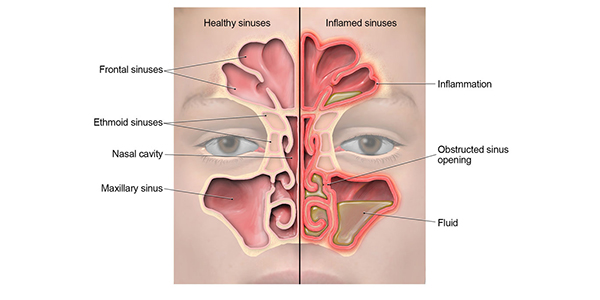While the world continues to reel from the Covid-19 pandemic and its latest Omicron variant, any symptom like those of a coronavirus infection is cause for concern. Sinusitis is one of the illnesses that present some similar symptoms. It is, therefore, important to correctly identify sinusitis.
According to the Centers for Disease Control and Prevention (CDC), the latest data shows that as of 2018, 28.9 million Americans were diagnosed to be suffering from sinusitis. This represents 11.6 percent of American adults.
What Is Sinusitis?
According to Harvard Medical School, sinuses are hollow chambers lined with thin mucus in the bones of the head. There are four pairs of sinuses located behind the nose, nose bridge, forehead, and cheekbones. A study published in the U.S. National Library of Medicine’s National Center for Biotechnology Information (NCBI) page states that the function of the sinuses is to filter out antigens such as microorganisms, dust, and other pollutants and drain these into the back of the nose for swallowing. There are tiny openings where the mucus normally drains from the sinuses to the nose.
The sinuses get inflamed when infected by viruses, allergies, or other bacteria. Viruses from the common cold and allergies are the most common causes of sinus blockage and inflammation. Sinusitis often occurs with rhinitis, hence, the term rhinosinusitis.
The mucus thickens and builds up, causing pressure and pain not just in the specific location of the sinuses but also behind the eyes and at the top of the head. Any mucus that comes out is thick and dark, accompanied by a foul smell and taste. The person can develop a cough and become feverish with body aches and fatigue. The person may also lose their sense of smell and taste temporarily.
There are four classifications of sinusitis. It is acute if symptoms last for less than a month and recurrent if there are four episodes lasting less than a month with complete recovery and no symptoms between episodes. On the other hand, it is subacute if it lasts between one and three months and chronic if the symptoms persist for more than three months.
The symptoms of sinusitis or rhinosinusitis are also some of the symptoms of Covid-19. Hence, if these symptoms appear, the person must get tested for Covid-19 to rule it out. It is possible to have sinusitis or rhinosinusitis and Covid-19 at the same time. It is imperative for people with any type of sinusitis to get full vaccinations and booster shots against Covid-19.
Avoiding Sinusitis
It is also best to avoid developing sinus inflammation now. This means avoiding getting a cold and triggering allergy. Air pollution, both outdoors and indoors, is one of the major triggers of sinusitis and rhinosinusitis. Avoid going to areas with smog or a lot of pollen. If it is unavoidable, wear a mask even if no other people are around. Indoors, ensure regular heating, ventilation, and air conditioning (HVAC) cleaning and maintenance services. Ensure that the HVAC filter has a Minimum Efficiency Reporting Value (MERV) of 13 or higher for it to trap smaller particles. MERV 20 is the highest level, but the MERV level must be compatible with the HVAC system. Install an ultraviolet (UV) light system inside the HVAC system to kill viruses and bacteria in the air.
Dry air can also trigger sinusitis. It irritates the sinuses, thickens the mucus, and causes inflammation. According to the Environmental Protection Agency (EPA), the best indoor air quality has a humidity level of 30 to 50 percent. Going above this can cause bacteria and molds to grow. Use a humidifier that can measure the humidity level and is easy to clean. Without regular, thorough cleaning, a humidifier can also spread bacteria and fungi in the air.
Treating Sinusitis
Harvard reserves the use of antibiotics only for severe bacterial sinusitis to avoid the development of antibiotic-resistant bacteria. The Sinus & Allergy Wellness Center states that even without antibiotics, 47 percent of episodes resolve within a week, and 70 percent resolve in two weeks.
The primary treatment method is to promote mucus drainage. Drinking lots of water will help thin out the mucus. Steam inhalation three to four times a day helps unclog the sinuses. This can be done by bending over a bowl of steaming water under a towel or staying in a steamy hot shower. Taking hot steaming soup throughout the day will also be helpful.
Nasal irrigation with a saline solution is another effective treatment method. Purchase a Neti pot for this purpose. It is filled with the saline solution which is poured into one nostril while bending sideways over the sink. The solution naturally drains out of the other nostril, taking the thick mucus with it. While doing this, breathe through the mouth.
The saline solution can be purchased or homemade. The base is one teaspoon of baking soda mixed with three teaspoons of plain salt with no additives. Add one teaspoon of this to eight ounces of lukewarm distilled or boiled water.
Once the condition is diagnosed as sinusitis and not Covid-19, the relief will make the person feel better. If there is fever and body pain, acetaminophen can provide relief in addition to a warm compress on the face. Lots of rest with the head elevated will hasten recovery.
